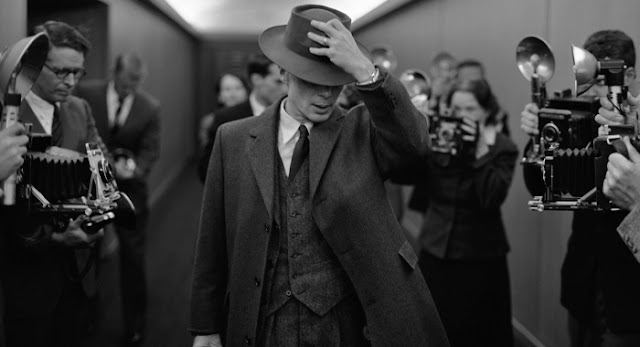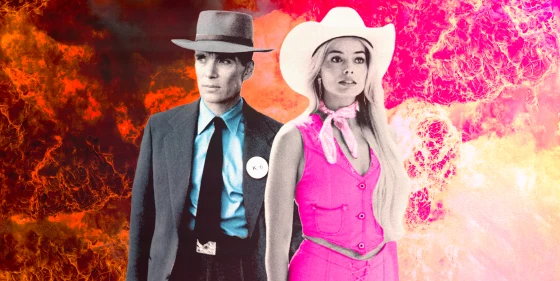
For months, the internet has been murmuring about the simultaneous release of Greta Gerwig’s Barbie and Christopher Nolan’s Oppenheimer. Two diametrically opposed films — sugar vs substance, pink vs black and white, divine feminine energy vs stark, intellectual masculinity — both dropping on the same fateful Friday in late July.
By mid-June, the phenomenon had a name, and #barbenheimer was heavily trending on Twitter and picked up by news outlets. People all over the world were talking about and gearing up for this pop culture explosion (pun intended, of course). It even had its own Wikipedia page.
Naturally, I made plans to take PTO and see them both on opening day — Oppenheimer at 3 p.m in 70 mm at the Plaza Theatre in Atlanta, then Barbie at Midtown Arts Cinema (a two-mile drive away) at 7 p.m.
Let’s start with the order
One of the things that has made #barbenheimer fun to discuss and debate is one’s preferred viewing order. I decided to go heavy and dark first, and then end the night with the fizzy, buoyant Barbie.
I’ll admit, it’s a weird feeling to spend three hours chronicling the break-neck race to build an atomic bomb and then dive headlong into a bright pink world filled with perfect dolls, but I think it’s the best order for viewing if you don’t want to end your marathon cinema experience too morose. It’s like having a steak, then getting dessert. It’s also easier, in my opinion, to sit through a long movie first then cap it with a short little number.
Oppenheimer, destroyer of worlds
As a caveat, I’m a Christopher Nolan fan. I admire the way he mixes the extremely serious with the dreamlike, the hard science with sentimentality (looking at you, love-exists-in-the-fourth dimension Interstellar).

The film chronicles the life of J. Robert Oppenheimer, beginning around college and following him all the way through into his old age. Cillian Murphy never once for a moment makes you believe he’s anyone other than Oppenheimer for the entire three hours. He’s incredible, and this portrayal will win an Oscar, I’m sure of it. I didn’t even think about Thomas Shelby once.
In the hands of any other director, a biopic about a physicist wouldn’t exactly be record-breaking box office fodder, but Nolan deftly makes this movie into a nail-biting thriller. Once we learn about the need for beating the Nazis to the atomic bomb, it becomes almost like a heist movie. Even Matt Damon is there, portraying the gruff engineer general tasked — along with Oppenheimer— with assembling the crew of scientists that will pull it off.
They build a town to house the scientists so they can work in seclusion in the deserts of New Mexico. The first two hours of the movie you learn about all of the interpersonal drama between the famous scientists of the day — names like Fermi, Einstein, Bohr, Heisenberg, Feynman. Ones you remember from chemistry class.
The end of the second act leads up to the Trinity test in New Mexico, and you’re on the edge of your seat the entire time. The explosion itself is divine, triumphant, frightening, mesmerizing. It builds in silence for 40 seconds before the shock wave hits the scientists — and you — with an otherworldly wall of hell-like noise (another Nolan specialty). The light that this bomb emitted was so bright that a girl blind from birth miles away reportedly asked what the brightness was.
In all honesty, I think the movie should have ended there. The last 40 minutes focus on the problems Oppenheimer ran into after the war. As the father of the atomic bomb, he was lauded as a hero at first, but as the reality of all the past — and future — blood on his hands sank in, he struggled with his feelings on all of it. He eventually spoke out against the creation of further weapons of mass destruction like the hydrogen bomb, and for this he was blacklisted and accused of being a communist. It’s a stark examination of the McCarthy era witch hunt mindset. But the next 50 years of the Cold War proved him right. Even though the world has yet to be destroyed by nuclear war, we came perilously close. And it still might happen.
Unlike Barbie, Oppenheimer only has two female characters, and they’re not terribly sympathetic. I know you can’t change reality, but it still kinda stings to have both ladies simply be the love interests of Oppenheimer. The first, his communist lover Florence Pugh, who spends the majority of her few minutes on screen completely naked. The second, his wife, played by Emily Blunt, a woman who hates her children and is an alcoholic.
Barbie, giver of hope
For my Barbie caveat, I will say that I never played with them growing up. I was a tried-and-true tomboy who loved Ninja Turtles and He-Man action figures. But Barbie is no ordinary doll movie — it’s directed by Greta Gerwig and co-written by her and her husband, Noah Baumbach. Early on the rumors leaked of it being a feminist movie, not what you’d expect. Of it being deeply funny and weird, also not what you’d expect.

We rushed from one theater to the next, driving down Ponce de Leon avenue in Atlanta during a thunderstorm with flooded streets. I won’t lie, this added to the cinematic nature of my afternoon.
Arriving into the lobby during the evening rush was a sea change. Pink everywhere, in every way you can imagine. Men wearing pink t-shirts. Young women decked in pink dresses and boas. I saw a group of Muslim girls wearing pink hijabs. It was fantastic! I had no idea how much people loved Barbie. And even though it’s never been my cup of tea, I was happy that people that did love it were reveling in the celebration. It’s easy for society to dismiss the things that women love when it comes to movies, so I beamed with pride that Barbie was having this moment.
But Barbie is being simultaneously praised — and derided — as a feminist movie.
Let’s get this straight: It is a deeply feminist movie in a way that I’ve never seen in a mainstream film, and certainly not in a way that I expected from a movie about a blonde doll.
The plot, briefly, is this: Barbie lives in Barbieland, an idyllic place where women are supreme court justices, presidents, astronauts, and more. As the first doll to not just be a baby or a mother, Barbie showed girls that women could be anything. And it was inspiring (for a while).
But that’s just in Barbieland. In the Real World, there’s still patriarchy and problems to be solved for gender equality. Barbie and Ken get to visit this Real World, and Ken very quickly learns that in the Real World, men are on top.
When they return to Barbieland, he spreads the gospel of patriarchy, turning their world upside down. It takes teamwork, probing, and self-examination, but Barbie and her friends learn the power they possess deep inside themselves, and eventually all is returned to normalcy in Barbieland.
I’m not doing the plot justice here, but the plot is secondary to the main point of the film. There’s an incredible scene in the climax of the movie where America Ferreira, playing an exhausted mom, gives a monologue about how hard it is being a woman, and all of the never-ending and impossible-to-fulfill demands placed upon them. The key message is: You are enough.
At this scene, a big chunk of the audience I was in started crying. This message is something that many women need to hear, and Greta Gerwig gave it to them. It was awe-inspiring.
Some detractors have claimed this movie is “anti-man” and filled with “nuclear-level rage” against men. It’s not. It’s a movie made for women about being a woman and all the complexities therein. And spoiler alert: There’s not many of these films.
Barbie is enjoyable, wildly funny, and very, very smart. The movie opens with a parody of Kubrick’s 2001: A Space Odyssey that had the entire audience cackling. There’s a reference to Proust! A character name drops Stephen Malkmus from the band Pavement. There’s a second Kubrick reference that combines The Shining with a Barbie.
As someone who never once desired to play with a Barbie, I’m struck by an overwhelming desire to see this movie again. I will, too.






Leave a Reply